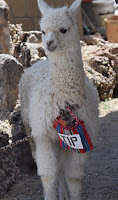 |
| Vicuna and Alpaca |
On Sunday, Jorge picked us up in the
hotel, in a van with a driver, Antonio, and we headed out into the
Altiplano. We got up to about 15,000 ft elevation, and saw more
alpacas than we believed possible. We also saw some vicuna, which we
had not seen before. They made us think about the Pronghorn antelope
in Wyoming, especially because the landscape reminded us of Wyoming.
Blanca also pointed out the Vizcacha rabbit, with its curling tail, which lives in the tundra.
Blanca also pointed out the Vizcacha rabbit, with its curling tail, which lives in the tundra.
 |
| Vizcacha, a large rabbit with a long tail. |
On Monday, Blanca and Antonio picked us
up at the hotel, and we headed for the Cruz de Condors, the overlook.
We stopped first in Yanque, where we watched students folkloric
dancing to raise money for school.
When we arrived at the Cruz de Condors, we saw condors almost immediately. At one point, we could see four condors at one time. There was a crowd of tourists there, but Blanca pointed me to a good seat on a rock. Most of the condors were immature, but one was partly mature, with a white neck.
We headed back to Chivay, and walked
through the market. Sandi bought a hat from a lady with an old
Necci sewing machine; she freehand sewed designs on hats.
We headed for Arequipa, stopping at the
pass at 4900 meters, about 16,000 feet. As we got closer to
Arequipa, we were somewhat horrified by the dusty squatter
neighborhoods, which looked very unattractive, and seemed to last for
an hour or so. We finally arrived at the main plaza and Casa Andina
Select hotel, a noticeable step up from the Casa Andina standard
hotels that we used in Puno and Chivay. We had a decent pasta dinner
at Lokanta, where we met yet another waiter from Venezuela. This had
become a thread running through the trip, that many waiters were from
Venezuela, fleeing the economic collapse there.
 |
| An escribino typing a letter in the square. A dying occupation of old men. |
On Tuesday, Blanca picked us up at the hotel, and we visited the Cathedral and the Monastery of Santa Catalina. When it was first founded, the Monastery (convent) was for daughters of rich families, who paid a dowry to join, and were permitted to have servants and live in a kind of apartment. The Monastery was like a city within the city, with roads, a plaza, a garden, and a mortuary. The Dominican nuns are still there, living in a portion of the monastery; the area we toured had been restored for tourism. We had a good tour from one of the guides of the monastery.







No comments:
Post a Comment